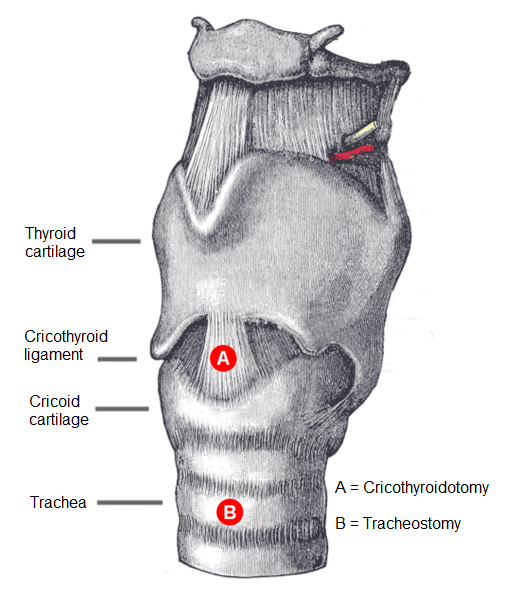.png)
Procedural Skills (SLO6)
Question 61 of 127
You have been asked to teach a group of medical students about airway rescue manoeuvres. You are currently discussing cricothyroidotomy. Which of the following is an advantage of needle cricothyroidotomy compared to surgical cricothyroidotomy?
Answer:
- Disadvantages
- Only a temporary measure - not a definitive airway
- Requires high-pressure oxygen source (at 400 kPa)
- May cause barotrauma, particularly in the presence of expiratory obstruction
- Particularly ineffective in patients with chest trauma
- Prone to failure because of kinking of the cannula
- Unsuitable for maintaining oxygenation during patient transfer
- Advantages
- Quick and easy
- Recommended in failed airway in child where surgical cricothyroidotomy is relatively contraindicated because of risk of damaging cricoid cartilage
Needle Cricothyroidotomy
Procedural Skills (SLO6)
Last Updated: 14th December 2023
Needle cricothyroidotomy involves insertion of a wide-bore non-kinking cannula through the cricothyroid membrane to provide oxygen on a short-term basis until a definitive airway can be placed.
Indications
- Can't intubate, can't oxygenate scenario
Advantages vs disadvantages
- Disadvantages
- Only a temporary measure - not a definitive airway
- Requires high-pressure oxygen source (at 400 kPa)
- May cause barotrauma, particularly in the presence of expiratory obstruction
- Particularly ineffective in patients with chest trauma
- Prone to failure because of kinking of the cannula
- Unsuitable for maintaining oxygenation during patient transfer
- Advantages
- Quick and easy
- Recommended in failed airway in child where surgical cricothyroidotomy is relatively contraindicated because of risk of damaging cricoid cartilage
Procedure
- Attach a syringe (preferably 20 mL) to a stiff cannula and needle (minimum 14 gauge in adults)
- Insert the cannula through the cricothyroid membrane into the airway at an angle of 45 degrees aiming caudally in the midline
- Confirm cannula position by aspiration of air with the syringe and advance cannula fully over the needle into the trachea
- Remove the needle, and aspirate air from the cannula to confirm position
- Hold the cannula in place, attach the ventilation system and commence ventilation
- One second of oxygen supplied at a pressure of 400 kPa (4 bar) and flow of 15 L/min should be sufficient to inflate adult lungs adequately
- This is followed by a 4 second pause to enable expiration via the upper airway (expiration does not occur via the cannula)
- In children the intial flow rate should equal the child's age in years, and this is increased in 1 L/min increments until one second of oxygen flow causes the chest to rise
- Look carefully for adequate exhalation through the upper airway (chest falls adequately with each expiration)
- The patient can be adequately oxygenated for 30 - 45 mins using this technique (because of inadequate exhalation, build up of CO2 occurs)
- If ventilation fails, or complications occur, proceed immediately to surgical cricothyroidotomy
Complications
- Barotrauma from high pressure ventilation including pulmonary rupture with tension pneumothorax
- Inadequate ventilation due to kinking or obstruction of the cannula
- Aspiration of blood
- Oesophageal laceration
- Haematoma
- Perforation of posterior tracheal wall
- Subcutaneous and/or mediastinal emphysema
- Thyroid perforation
Clinical anatomy

Site of Airway Procedures. (Image by PhilippN [CC-BY-SA-3.0 , via Wikimedia Commons)
Report A Problem
Is there something wrong with this question? Let us know and we’ll fix it as soon as possible.
Loading Form...
- Biochemistry
- Blood Gases
- Haematology
| Biochemistry | Normal Value |
|---|---|
| Sodium | 135 – 145 mmol/l |
| Potassium | 3.0 – 4.5 mmol/l |
| Urea | 2.5 – 7.5 mmol/l |
| Glucose | 3.5 – 5.0 mmol/l |
| Creatinine | 35 – 135 μmol/l |
| Alanine Aminotransferase (ALT) | 5 – 35 U/l |
| Gamma-glutamyl Transferase (GGT) | < 65 U/l |
| Alkaline Phosphatase (ALP) | 30 – 135 U/l |
| Aspartate Aminotransferase (AST) | < 40 U/l |
| Total Protein | 60 – 80 g/l |
| Albumin | 35 – 50 g/l |
| Globulin | 2.4 – 3.5 g/dl |
| Amylase | < 70 U/l |
| Total Bilirubin | 3 – 17 μmol/l |
| Calcium | 2.1 – 2.5 mmol/l |
| Chloride | 95 – 105 mmol/l |
| Phosphate | 0.8 – 1.4 mmol/l |
| Haematology | Normal Value |
|---|---|
| Haemoglobin | 11.5 – 16.6 g/dl |
| White Blood Cells | 4.0 – 11.0 x 109/l |
| Platelets | 150 – 450 x 109/l |
| MCV | 80 – 96 fl |
| MCHC | 32 – 36 g/dl |
| Neutrophils | 2.0 – 7.5 x 109/l |
| Lymphocytes | 1.5 – 4.0 x 109/l |
| Monocytes | 0.3 – 1.0 x 109/l |
| Eosinophils | 0.1 – 0.5 x 109/l |
| Basophils | < 0.2 x 109/l |
| Reticulocytes | < 2% |
| Haematocrit | 0.35 – 0.49 |
| Red Cell Distribution Width | 11 – 15% |
| Blood Gases | Normal Value |
|---|---|
| pH | 7.35 – 7.45 |
| pO2 | 11 – 14 kPa |
| pCO2 | 4.5 – 6.0 kPa |
| Base Excess | -2 – +2 mmol/l |
| Bicarbonate | 24 – 30 mmol/l |
| Lactate | < 2 mmol/l |

